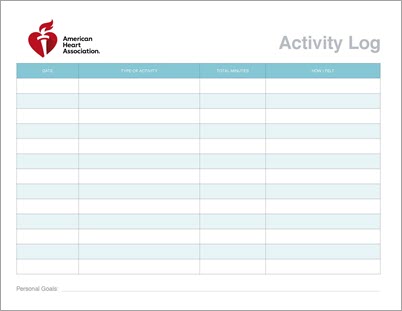Develop a Physical Activity Plan for You
Work with your health care team on a physical activity plan that works for your needs and abilities. They will tell you what activities you should avoid and what signs and symptoms to monitor.
To stay healthy and keep doing the things you enjoy, health experts recommend incorporating all three types of physical activities:
- Aerobic exercise to strengthen and keep your heart healthy
- Strength exercises to keep other muscles of the body in good condition and help your sense of balance
- Stretching exercises to keep muscles flexible
Building Up
If you've recently had a heart attack or other cardiac event or have had heart surgery or a cardiac procedure, it may take time to reach your physical activity goal. Work with your doctor or cardiac rehabilitation specialist to establish a routine for you. You may also need an exercise stress test before you become active again. As you feel ready and as your health care team allows, start to increase the amount of physical activity you do. Work up to at least 150 minutes of aerobic physical activities each week, along with stretching and strengthening exercises at least two days per week, or whatever treatment goal your health care team recommends.
Stretching, strength and balance
Stretching exercises and strength and balance exercises will help you learn simple activities. You can do these activities at home, work or even when you're on vacation. All you need is a straight-backed, armless chair and two hand weights. Weights can be books, bottles of water or cans of food weighing about one to two pounds. You can work up to heavier weights as you get stronger.
If you had surgery, it's important not to push, pull, twist your body or lift anything heavier than five pounds for up to six weeks after your procedure. Your health care team will tell you if you should avoid other movements or activities.
You'll repeat each activity eight to 12 times. These are called repetitions, or "reps." One group of repetitions is called a set. As your fitness improves, you can increase the number of repetitions. You can also rest a couple of minutes and do another set.
Make sure that you're wearing comfortable, loose-fitting clothing and tennis shoes. Stay hydrated by drinking plenty of water.
Download our patient information sheet: How Can Physical Activity Become a Way of Life? English (PDF) | Spanish (PDF)
Be safe while being active
Warm up and cool down
Before you start and after you finish aerobic or strengthening activities, walk slowly for five to 10 minutes. Warming up and cooling down allows a gradual increase in heart rate and breathing at the start of your workout, as well as a gradual decrease at the end. After a workout, do some stretching to help improve flexibility.
Monitor your intensity
Your health care team will tell you how intense your physical activity should be — probably between a fairly light intensity and a hard intensity. A good rule of thumb is to work hard enough to breathe harder but still be able to carry on a conversation. If you can sing, you may not be working hard enough. You may also need to monitor your heart rate (pulse) and blood pressure.
Discuss any questions you have about the type and amount of physical activity you should do with your health care team.
Watch for warning signs
Warning signs that you're working too hard include:
- Angina: a feeling of squeezing, burning, pressure, heaviness or tightness under the breastbone that may spread to your left arm or shoulder, back, throat or jaw
- Feeling lightheaded, dizzy or confused
- Feeling extremely tired after physical activity
- Unusual or extreme shortness of breath
- Fast or uneven heartbeat
If you notice these signs during or after physical activity, stop and call your health care professional right away. If your angina lasts for more than a few minutes, or if you also have other symptoms, such as nausea and sweating, call 911 or have someone take you to the nearest emergency room. You may be having a heart attack.





